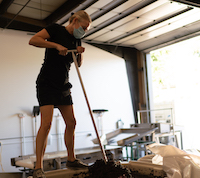What is native fermentation?

What is native fermentation?
Native fermentation is using the indigenous yeasts from the vineyard to cause primary fermentation i.e. the process where the sugar in the grapes turns to alcohol.
When I’m working with grapes that I know are going to go to the Jezebel pinot noir, I usually inoculate them with yeast. There are a few that I tend to use more often and they’re mostly designed to highlight the fresh fruit flavors of the wine and contribute to a fleshy mouthfeel. The fermentations with these yeasts tend to be fairly uniform each year, and shorter than the wild yeasts I use for the Willful pinot noir. The yeasts are one of the tools that help me to maintain consistency each vintage.
I approach the “willful” pinot noir grapes a little differently. I do a “cold soak” for at least a week, where I keep the grapes in a chiller (usually around 48F). This allows the grape juice to be in contact with the skins for longer and builds structure in the wine, especially the more elegant type of tannins that I prefer. Then I let the fermenters warm up and whatever yeasts came in from the vineyard with them go to work and turn the sugar in to alcohol and the juice into wine. The native ‘wild’ yeasts generally ferment at lower temperatures and take longer to convert all of the sugar in to alcohol and this gives me yet more skin time to build structure in the wine, and also tends make the wines a little more aromatic. Naturally fermented wines tend to have a particularly supple, velvety texture.
I often refer to my wines as children. You have an idea of what you're going to get, but they also often surprise you, and that's one of the things I love about winemaking in general, and about native yeasts. I find they do require a little more work in the winery but I think the variety of terroir and nuance that can be expressed and the impact on the texture is well worth it to me.
Comments
Commenting has been turned off.Recent Posts
-
November 16, 2024
-
May 11, 2024
-
August 8, 2023
-
December 10, 2022
-
August 6, 2022
-
March 31, 2022
-
January 17, 2022
-
December 1, 2021
-
June 2, 2021
-
March 31, 2021